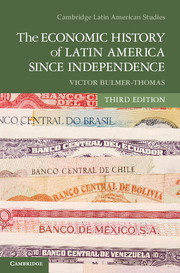Book contents
- Frontmatter
- Dedication
- Contents
- List of Tables, Figures, and Maps
- Preface to the Third Edition
- Preface to the First Edition
- List of Abbreviations
- 1 Latin American Economic Development
- 2 The Struggle for National Identity
- 3 The Export Sector and the World Economy, circa 1850–1914
- 4 Export-Led Growth
- 5 Export-Led Growth and the Nonexport Economy
- 6 The First World War and Its Aftermath
- 7 Policy, Performance, and Structural Change in the 1930s
- 8 War and the New International Economic Order
- 9 Inward-Looking Development in the Postwar Period
- 10 New Trade Strategies and Debt-Led Growth
- 11 Debt, Adjustment, and the Shift to a New Paradigm
- 12 Conclusions
- Appendix 1 Data Sources for Population and Exports before 1914
- Appendix 2 The Ratio of Exports to Gross Domestic Product, the Purchasing Power of Exports, the Net Barter Terms of Trade, and the Volume of Exports, circa 1850 to circa 1912
- Appendix 3 Population, Exports, Public Revenue, and GDP for the Main Latin American Countries before 1914
- Appendix 4 GDP Per Head in Latin America since 1900
- Bibliography
- Index
1 - Latin American Economic Development
An Overview
Published online by Cambridge University Press: 05 June 2014
- Frontmatter
- Dedication
- Contents
- List of Tables, Figures, and Maps
- Preface to the Third Edition
- Preface to the First Edition
- List of Abbreviations
- 1 Latin American Economic Development
- 2 The Struggle for National Identity
- 3 The Export Sector and the World Economy, circa 1850–1914
- 4 Export-Led Growth
- 5 Export-Led Growth and the Nonexport Economy
- 6 The First World War and Its Aftermath
- 7 Policy, Performance, and Structural Change in the 1930s
- 8 War and the New International Economic Order
- 9 Inward-Looking Development in the Postwar Period
- 10 New Trade Strategies and Debt-Led Growth
- 11 Debt, Adjustment, and the Shift to a New Paradigm
- 12 Conclusions
- Appendix 1 Data Sources for Population and Exports before 1914
- Appendix 2 The Ratio of Exports to Gross Domestic Product, the Purchasing Power of Exports, the Net Barter Terms of Trade, and the Volume of Exports, circa 1850 to circa 1912
- Appendix 3 Population, Exports, Public Revenue, and GDP for the Main Latin American Countries before 1914
- Appendix 4 GDP Per Head in Latin America since 1900
- Bibliography
- Index
Summary
The expression “Latin America,” whose origin goes back to the mid-nineteenth century, at first had little more than geographical significance – it referred to all those independent countries south of the Río Grande in which a language derived from Latin (i.e., Spanish, Portuguese, and French) was predominantly spoken. In this original meaning, the only characteristics common to the countries of Latin America were their location in the Western Hemisphere and the origins of their language. In many respects the differences between the countries were considered to be as important – if not more so – as what they shared.
These differences – whether of size, population, ethnicity, natural resources, climate, or level of development – are still very important, but it has also become clear that the republics are held together by much more than geography and language. The shared colonial experience, as divisions above all of the Spanish or Portuguese empires, was crucial in shaping the economic and political destinies of the new republics after independence. The pattern of development in the nineteenth century, based on the export of natural resources to the industrialized countries, reinforced this sense of a shared past.
- Type
- Chapter
- Information
- Publisher: Cambridge University PressPrint publication year: 2014

